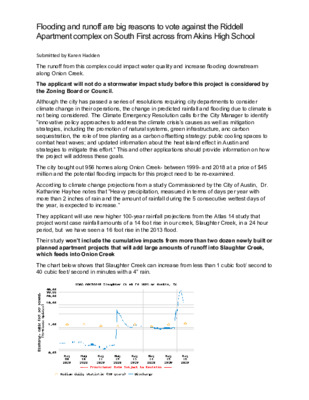B-01 (Karen Hadden) — original pdf
Backup

Flooding and runoff are big reasons to vote against the Riddell Apartment complex on South First across from Akins High School Submitted by Karen Hadden The runoff from this complex could impact water quality and increase flooding downstream along Onion Creek. The applicant will not do a stormwater impact study before this project is considered by the Zoning Board or Council. Although the city has passed a series of resolutions requiring city departments to consider climate change in their operations, the change in predicted rainfall and flooding due to climate is not being considered. The Climate Emergency Resolution calls for the City Manager to identify “innovative policy approaches to address the climate crisis’s causes as well as mitigation strategies, including the promotion of natural systems, green infrastructure, anc carbon sequestration, the role of tree planting as a carbon offsetting strategy: public cooling spaces to combat heat waves; and updated information about the heat island effect in Austin and strategies to mitigate this effort.” This and other applications should provide information on how the project will address these goals. The city bought out 956 homes along Onion Creek- between 1999- and 2018 at a price of $45 million and the potential flooding impacts for this project need to be re-examined. According to climate change projections from a study Commissioned by the City of Austin, Dr. Katharine Hayhoe notes that “Heavy precipitation, measured in terms of days per year with more than 2 inches of rain and the amount of rainfall during the 5 consecutive wettest days of the year, is expected to increase.” They applicant will use new higher 100-year rainfall projections from the Atlas 14 study that project worst case rainfall amounts of a 14 foot rise in our creek, Slaughter Creek, in a 24 hour period, but we have seen a 16 foot rise in the 2013 flood. Their study won’t include the cumulative impacts from more than two dozen newly built or planned apartment projects that will add large amounts of runoff into Slaughter Creek, which feeds into Onion Creek The chart below shows that Slaughter Creek can increase from less than 1 cubic foot/ second to 40 cubic feet/ second in minutes with a 4” rain. We’d like to ask ZAP to require the developer to: 1. Reduce the zoning to MF-2 or MF-3 to reduce the run off. 2. Use pervious pavers. 3. Collect rainfall from the roof for irrigation. 4. Build a series of swales and berms to retard runoff. 5. Account for climate change in their runoff planning and reduce runoff to projected 2100 levels of flooding 6. Add numerous electric vehicle charging stations to reduce carbon emissions.